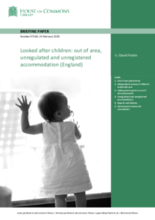Displaying 481 - 490 of 2214
This study draws on data from the [STUDY] and the National Student Clearinghouse to examine the roles that Education and Training Vouchers (ETVs) and campus support programs (CSPs) play in promoting college persistence for foster youth.
This briefing provides information on two separate but related topics concerning looked after children in England: out of area and distant placements and unregulated and unregistered accommodation
This qualitative research explored the motivations and challenges of foster parents in Accra, Ghana.
The purpose of the present study was to examine differences in both internalized (e.g., worry and guilt) and externalized (e.g., anger and resentment) caregiver strain among biological, foster and adoptive caregivers, and assess the degree to which characteristics of the caregivers and the children in their care impact strain.
This article examines the distinctive campaign of foster carers to be recognised as workers, focusing upon the emergence of the campaign and the imaginative solidarities forged with seemingly disparate groups of precarious workers.
This study explores immigrant parents’ emotional experiences in child welfare services as well as parents’ emotional management and their interpretations of the role of emotions in the child welfare system.
The purpose of this study was to describe the demographics, state-dependent living situations, and juvenile detention usage of state-dependent commercially sexually exploited youth.
Using a sequential, mixed methods approach, data from 115 sexually active African American youth in foster care (17-20 years old) were analyzed to determine their level of protection and whether gender was a factor in their prevention efforts.
The purposes of this study are to document and analyse the point of view of children in foster families on their subjective well‐being and also to identify contextual factors that influence it.
The purposes of this study are to document and analyse the point of view of children in foster families on their subjective well‐being and also to identify contextual factors that influence it.

